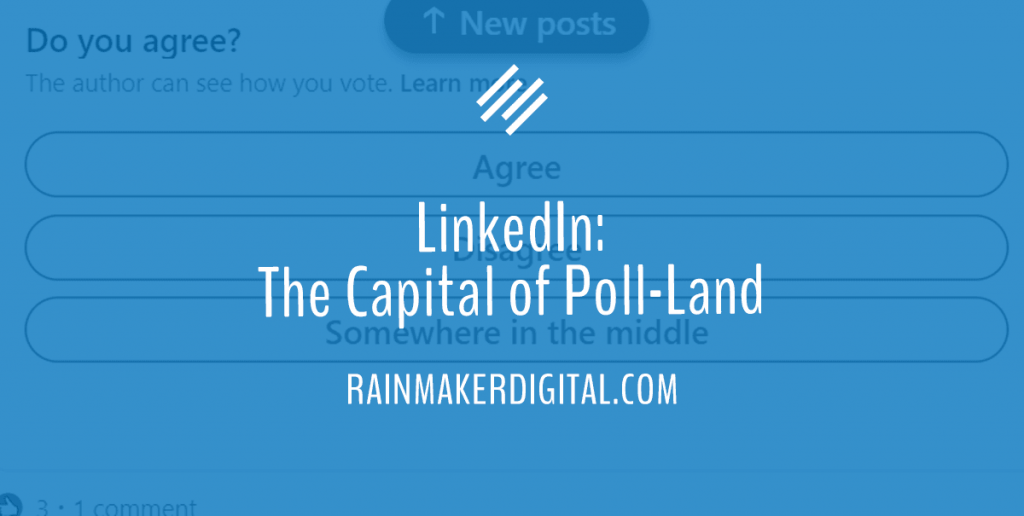
If your LinkedIn feed is anything like mine, it’s full of polls.
People love to share their opinions, and polls are an easy, low-friction way for them to engage. LinkedIn knows this — and so do the people that use it on a daily basis. Polls have power. But as Spiderman says (and the ancient adage goes), “with great power comes great responsibility.”
Just like any other tool of the trade, LinkedIn polls can backfire if you’re not intentional with how you use them. You need to understand what makes LinkedIn polls effective — as well as how they can turn off your audience.
Why Use LinkedIn Polls
LinkedIn has changed its algorithm to make polls more visible. According to one September 2021 algorithm study, polls get four to five times more reach than a regular post. That alone is the biggest reason for the poll tsunami washing over your feed. Since LinkedIn loves polls, we’ve seen a boost in people adding them to regular posts as a way to expand reach and bump up engagement.
It’s not just the algorithm, though. A poll is a great marketing tactic. It can spark a conversation and generate feedback. It’s almost frictionless. All your audience has to do is click a single button, and if they want to add more, they can use the comments.
Polls stimulate engagement, and engagement keeps your posts in the feed. And the more people see your posts, the more they can interact with them. There can be a downside, though.
Poll Poisoning
We’re already seeing some backlash on polls from people who use LinkedIn regularly. Just search “sick of polls” and you’ll see hundreds of posts from people who are tired of having their feed taken over.
It’s understandable, as one power user points out in his complaint. “The way I see it, there are two reasons for the proliferation of Polls on LinkedIn,” he says. “The first is that the algorithm for some reason seems to think that Polls are what we want to see. The second is that when people see LinkedIn rewarding Polls with prime placement in the feed, that’s what people are going to post. And how can you blame LinkedIn users if they see LinkedIn rewarding the Pollsters?”
“Marketers ruin everything,” as the saying goes. If it works, it will eventually get oversaturated. And the polls we’re starting to see now are not always providing value. When too much of the feed is consumed with useless content, your audience will turn off.
These days many people are just posting low-effort content to get clicks on their polls because they know it will get them reach. But cluttering people’s feeds is a great way to make sure they stop listening to what you have to say.
Quantity is less important than quality. Is this part of a plan? Does the post actually need a poll? Start asking. LinkedIn isn’t Facebook, with its family updates and fun polls and event pictures. It’s aimed at professionals. Don’t waste your audience’s time with inanities.
Using Polls Correctly
The good news is, if you’re using LinkedIn polls intentionally, they’re a powerful tool still. Here are some basics to get you started.
Pew Research recommends a questionnaire design that:
- Uses as few answers as you can. Psychological research indicates that four or five answers is the maximum number that people can hold in their minds at once. Less is better than more.
- Asks “close-ended” (with a limited number of options) questions on polls by default. You can circumvent this with an “other” answer that allows people to answer in the comments if you want. Open-ended and closed-ended questions tend to get different answers.
- Clearly defines answers and makes sure the answer is REALLY what you’re looking for. You need to make sure each concept is unmistakable, or the feedback you get will be misleading or useless.
And you should also be aware of the following:
- The best times to post are just before work, just after work or around lunch (based on your chosen geographical audience). That means 7–8 a.m., 5–6 p.m. or 11–2 p.m. It may vary slightly based on your vertical.
- Structure your question carefully. Avoid double negatives, double-barreled questions or leading questions. Balance your verbs (for example, “support” would always be paired with “or oppose,” or it would shade the results toward support).
Maximizing Your Poll Power
LinkedIn polls are popular for a reason. They’re a great way to create and continue conversations. They also allow you to glean useful information for follow-up posts later. And they give you wider reach than many other post types.
You can use them to effectively engage with your audience — if you’re not spamming them with low-effort content. Use them wisely and you’ll reap the dividends. And, if you need a little assistance with your social media efforts, feel free to reach out. We’re here to help.
Best Regards,
Ed Bardwell
President
Rainmaker Digital Services